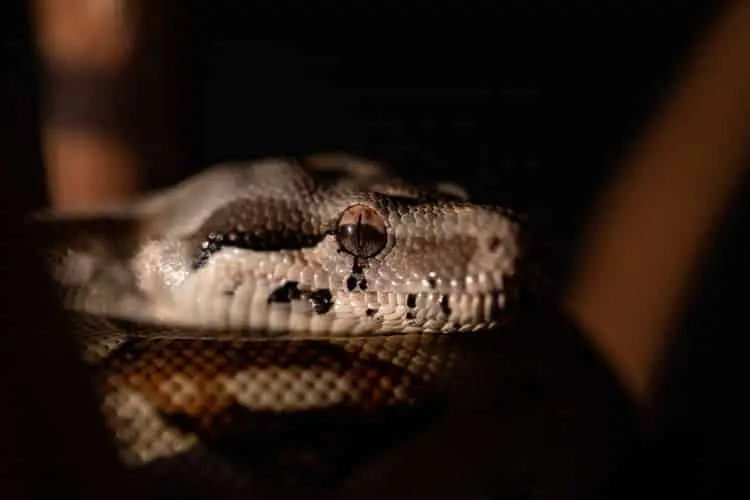Embark on a thrilling escapade into the heart of the wild – a journey where the allure of encountering a magnificent boa constrictor snake becomes a reality! Imagine the beauty of witnessing these non-venomous serpents in their natural habitat, all while maintaining a safe and respectful distance. Your dream adventure awaits, and we have just the serpentine companions to make it an unforgettable experience!
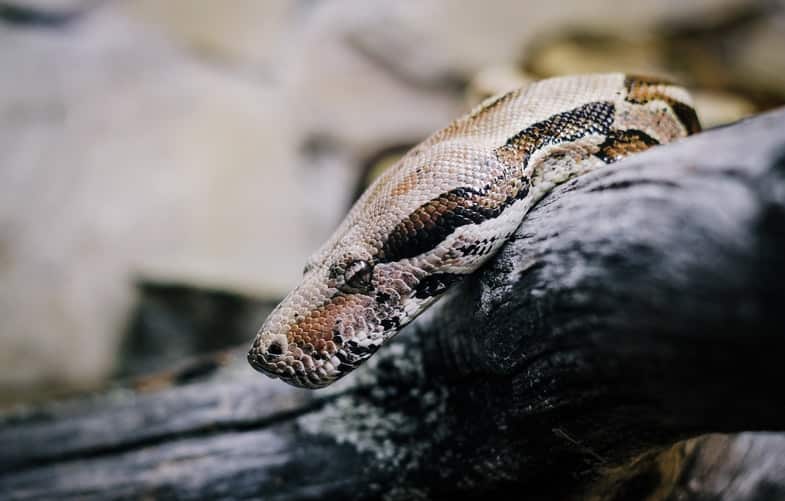
Boa Constrictor snakes and where to find them ( if you’re lucky).
Learn more about different snakes in our articles about snakes around the globe.
A constrictor is a snake that kills prey by constriction.
Are you intrigued? Read on or jump ahead to discover where you can see Boa constrictors in the wild and what makes them so unique…
Boa Constrictor Characteristics
Boa Constrictor is a common name for a variety of nonvenomous constricting snakes. There are more than 40 species of true boas (family Boidae).
In addition, boa may also refer to two other groups of snakes: the Mascarene, or split-jawed, boas and dwarf boas (ground and wood boas of the family Tropidophiidae).
The true boas are divided into two subfamilies, Boinae and Erycinae. Boinae includes the boa constrictor, tree boas (genus Corallus), and anacondas (genus Eunectes) of the American tropics; two other genera are found on Madagascar and islands of the southwestern Pacific.
Boas are found in Mexico, Central and South America, and Madagascar. The giant member of the group is the boa constrictor, but it is important to note that this is only one boa species—all boas are constrictors.
| COMMON NAME: Boa Constrictor |
| SCIENTIFIC NAME: Boa constrictor |
| TYPE: Reptiles |
| DIET: Carnivore |
| GROUP NAME: Bed, knot |
| AVERAGE LIFE SPAN IN THE WILD: 20 to 30 years |
| SIZE: 13 feet |
| WEIGHT: 60 pounds |
Probably the best-known characteristic of boa constrictors is their method of killing. Boas are not venomous; they kill their prey by constricting or squeezing it to death.
Boa Constrictor Physical Characteristics
Boa constrictors typically measure between 6.5 and 9.8 feet (2 and 3 m) in length and can weigh over 100 lbs. (45 kilograms). In comparison, green anacondas can reach lengths of nearly 20 feet (6 m), and reticulated pythons are commonly found between 16 to 25 feet (4.8 to 7.6 m).
Boa constrictors are identifiable by markings on their heads, often featuring a stripe extending from the snout to the back of the head. Additionally, a dark triangle between the nose and eyes persists behind the eyes, sloping downward toward the snake’s jaw. These snakes may also display sporadic spots across their bodies.
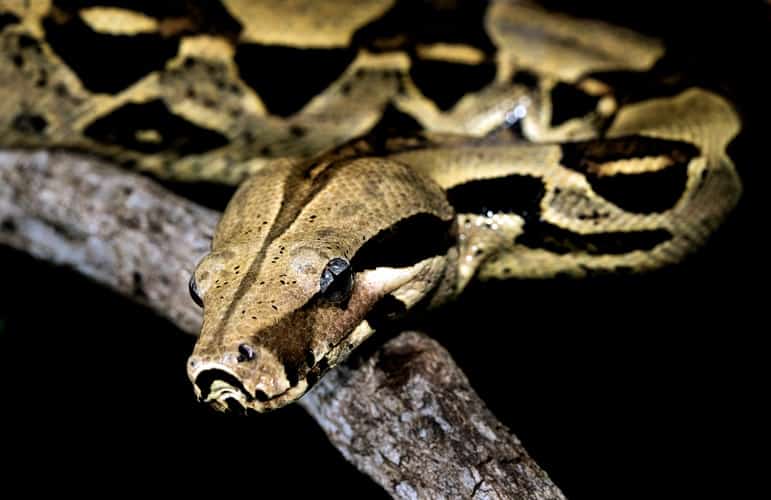
Boa constrictors use small, hooked teeth to grab and hold prey. If their teeth fall out or become damaged, they can regrow them. Boa constrictors do not have fangs, but their jaws can stretch incredibly wide, allowing them to swallow large prey.
Boa Constrictor Range
Boa constrictors are New World snakes living exclusively in the Western hemisphere. but certain boa species have been discovered in remote areas such as Mauritius and New Guinea.
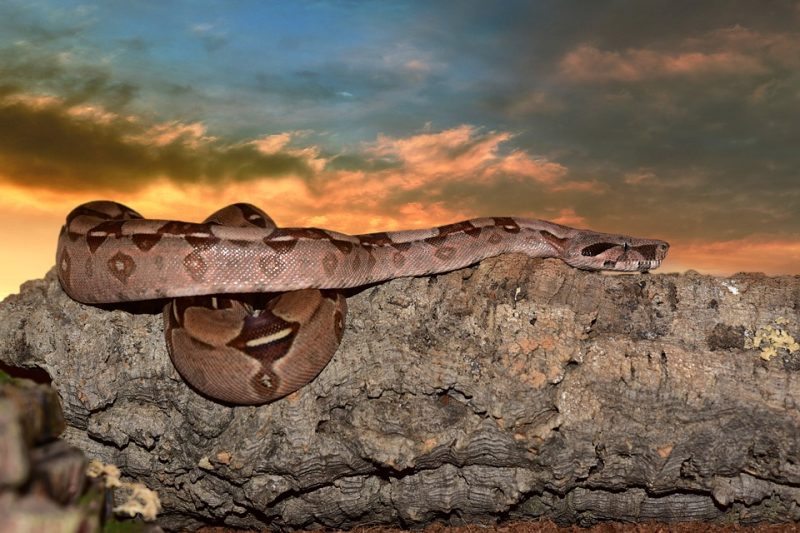
Boa Constrictor Habitats
When they do reside in rainforests, they tend to stick to the edges or clearings. They can also be found in dry tropical deserts, semi-deserts, woodlands, and scrub and agricultural areas. They are often found near streams or rivers.
Behavior/ Do Boa Constrictor snakes swim?
Boas tend to be solitary until mating time. They are primarily nocturnal, though they sometimes come out to sun themselves in cooler temperatures during the day.
They are excellent swimmers but prefer to stay on dry land, living primarily in hollow logs and abandoned mammal burrows.
Diet/ What do Boa Constrictor snakes eat?
Boa constrictors’ diets are composed chiefly of small mammals like rats and squirrels. bats are a favorite food, which boa constrictors catch while hanging from trees or the mouths of caves, snatching their prey as it flies by.
Though most of their prey is not astoundingly large, boa constrictors will eat anything they can get their enormous, stretchable jaws around. This includes monkeys, pigs and deer.
Boa Constrictor Constriction
Boas are not venomous; they kill their prey by constricting or squeezing it to death.
Boa Constrictor Reproduction
Boa constrictors are ovoviviparous, meaning they give birth to live young. Their gestation period is about five to eight months, depending on the local temperature.
Females give birth to litters that range from 10 to 64 young. Once born, boa constrictors are fully independent.
Boa Constrictor Conservation
Some populations of boa constrictors have come under threat from hunters seeking their attractive skins and meat. They have also faced habitat loss from urban and agricultural development and increased danger from road vehicles. Boa constrictors have also been overly collected for the pet trade.
Myths of Boa Constrictor
Are Boa Constrictors Dangerous? Boa constrictors rarely, if ever, attack people except in self-defense. They have been vilified in pop culture horror films but, in reality, are very hard to see in the wild and, even when encountered, will retreat.
They are even considered one of the most popular pet snakes, domesticated in many homes as beloved companions. Boas can be terrific, safe-to-keep, low-maintenance pets.
They are often active and alert and usually tolerate handling well. Captive boa constrictors can live in excess of 20 years with proper care and husbandry.” – Reptile’s magazine. Does this change your view of boas?
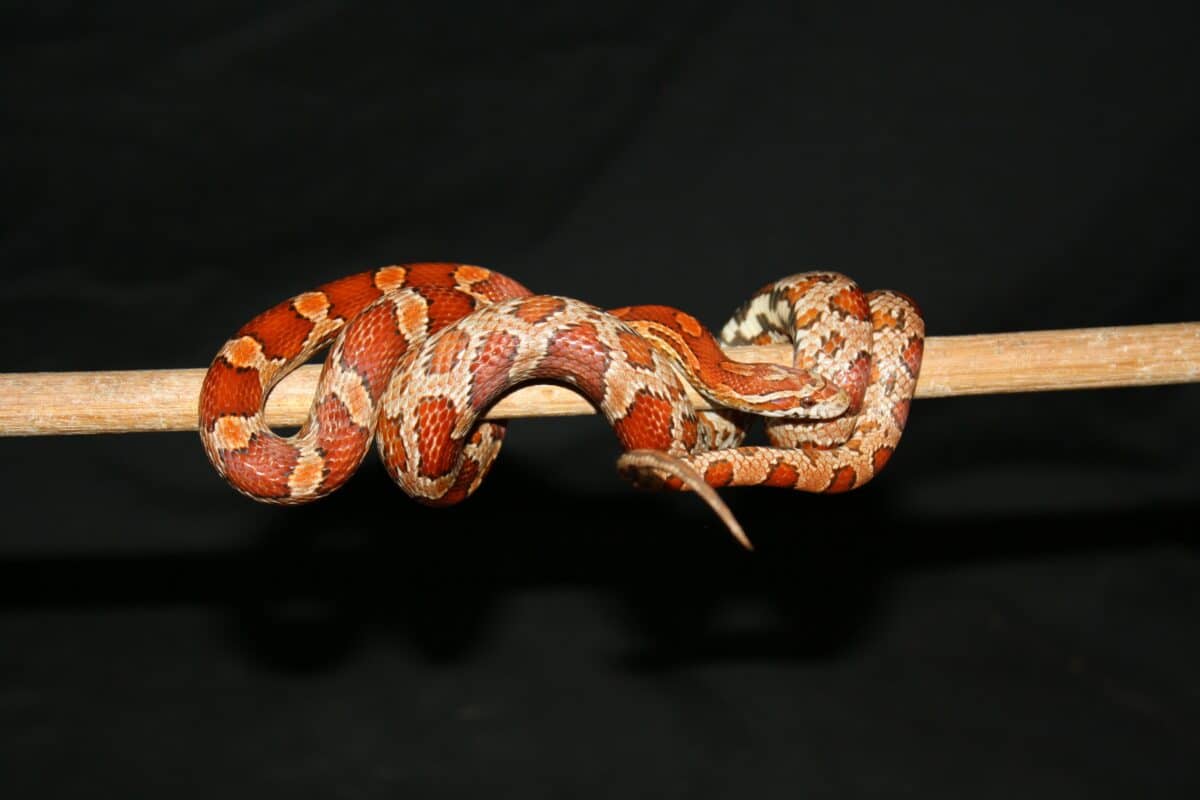
Boas
Boas, collectively known as boines in South America, hold the distinction of being the most renowned snakes globally.
Within the extensive boine fauna of the Amazon River Basin and the Guianas, five species stand out: the boa constrictor, the emerald tree boa (Corallus caninus), the common tree boa (C. enydris), the rainbow boa (Epicrates cenchria), and the green anaconda (Eunectes murinus).
Given their need to consume prey whole, large boas like the boa constrictor can ingest a variety of sizes, from a 210-gram roof rat to a substantial 9-kilogram capybara. Different boa species exhibit preferences for specific habitats, such as trees or rivers. By specializing in distinct prey items, they manage to coexist with minimal competition among themselves.
Different types of Boas
The Anaconda
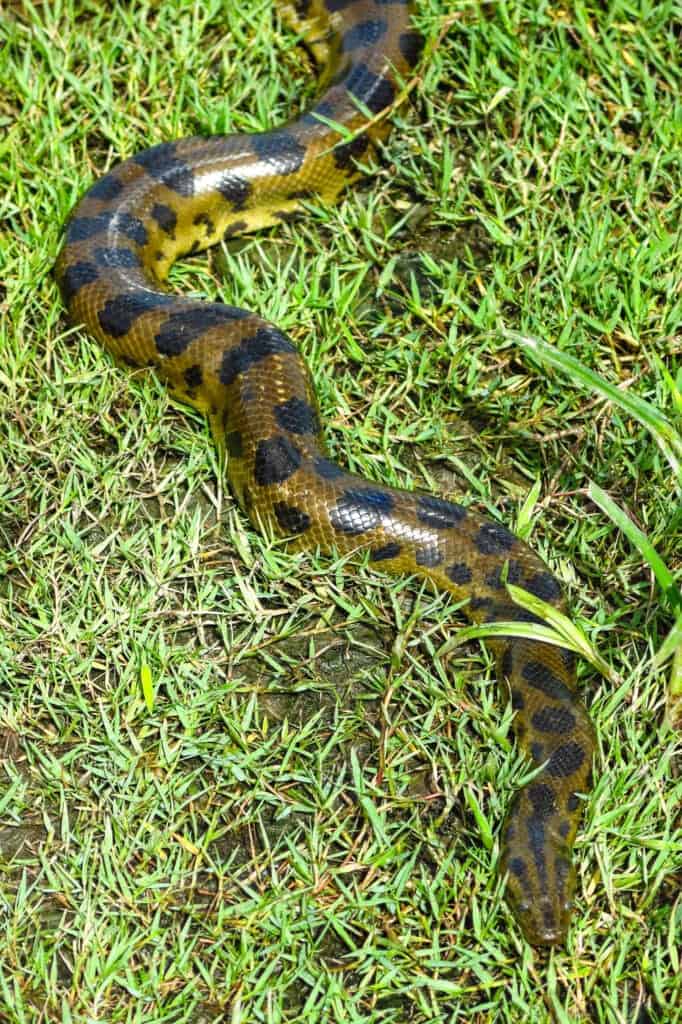
Boa Constrictors and Anacondas inhabit the marshes, swamps, and sluggish waterways within the Amazon and Orinoco basins in South America. While relatively slow on land, they exhibit stealth and agility in the water.
Positioned on the tops of their heads, their eyes and nasal passages allow these snakes to submerge themselves nearly entirely in the water. This unique adaptation aids them in patiently awaiting prey and approaching their hiding spots.
The Boa Constrictor, known for its diverse coloration, typically appears in shades of brown, grey, or cream with red and brown patterns, intensifying near the tail, as observed in the red-tailed boa. This coloring serves as effective camouflage in the jungles and forests of South and Central America, their primary habitats. Although they thrive in the humidity of rainforests, Boa Constrictors can adapt and survive even in near-desert climates when necessary.
Emerald Tree Boa

- Emerald Tree Boa constrictors are seldom spotted on the ground. Instead, they prefer to coil around tree branches, patiently waiting for prey to approach. With a metabolism slower than that of many other snakes, they can go for extended periods, even months, without consuming food. This snake species primarily resides in the rainforests of South America. Notably, they possess front teeth that are exceptionally well-developed and proportionately larger than those of other nonvenomous snakes. Female Emerald Tree Boas give birth to live young, typically delivering an average of 6 to 14 offspring at a time, and sometimes even more.
Garden Tree Boa
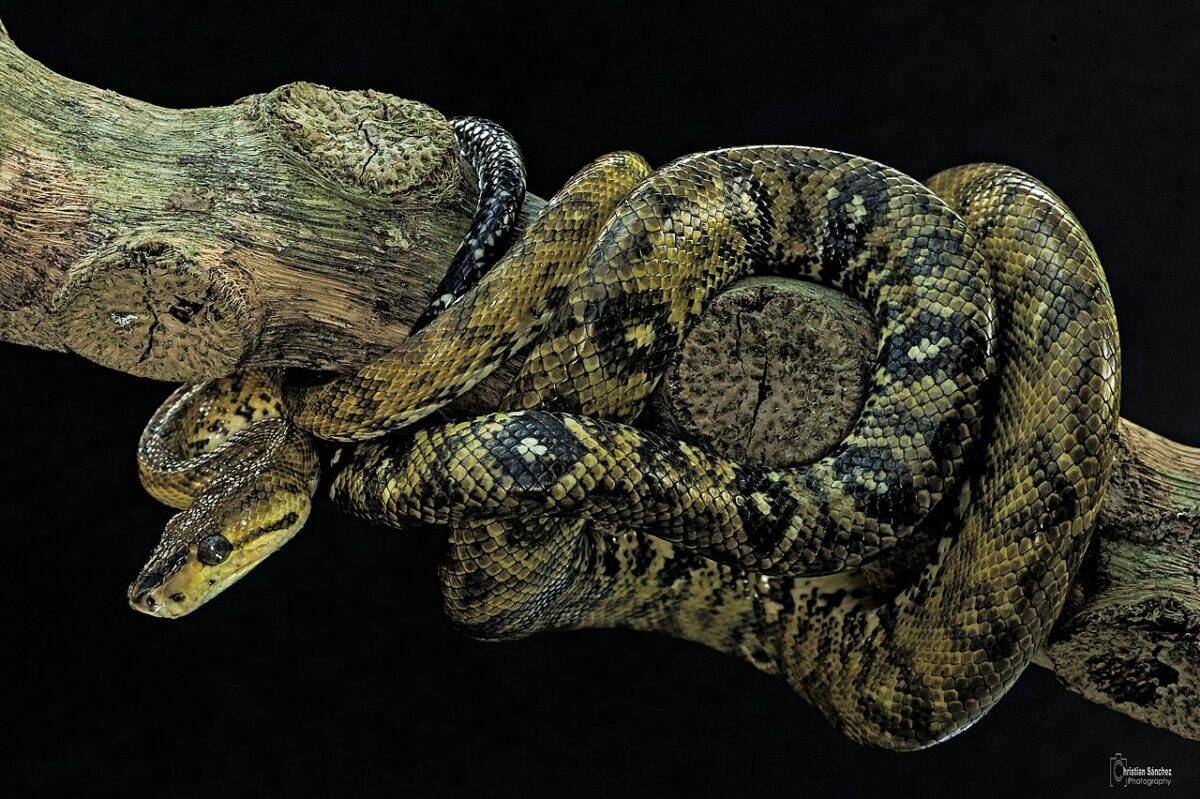
- Inhabiting the Amazon rainforests of South America, the Garden Tree Boa is an exquisite nonvenomous snake known for its vibrant colors. The species showcases a diverse range, with some individuals being entirely patternless, while others feature speckles, bands, or distinct rhomboid or chevron shapes. The color palette includes variations such as red with yellow patterns or yellow with red or orange patterns. Notably, these snakes are slender compared to most other boas and exhibit a relatively lightweight build considering their length.
Rainbow Boa
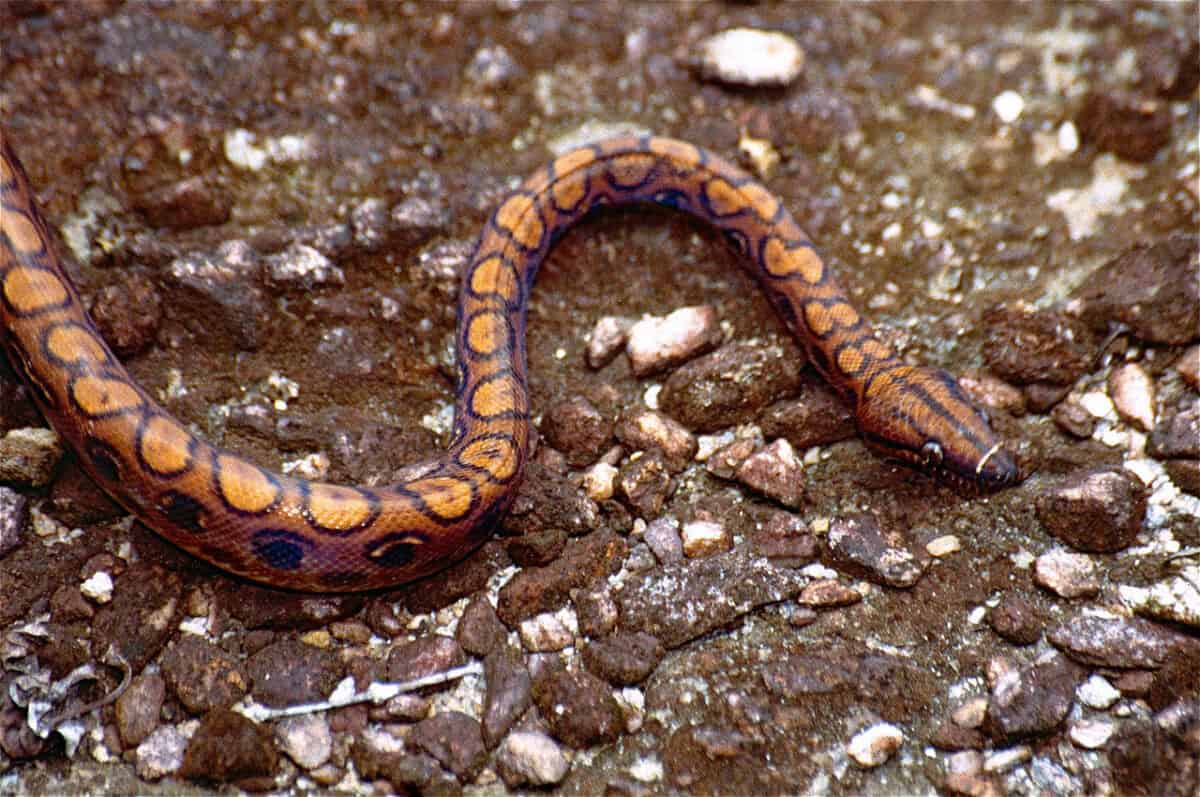
- This boa species are found in Central and South America but are most prominent in Suriname. The most colorful species live in the Brazilian rainforest. Although it is a complex animal to raise in captivity, it is a common pet. It gets its name from the iridescent sheen of its scales, not the actual color. Most Rainbow Boas are red to orange in color, with distinct, usually circular, black markings.
Rosy Boa
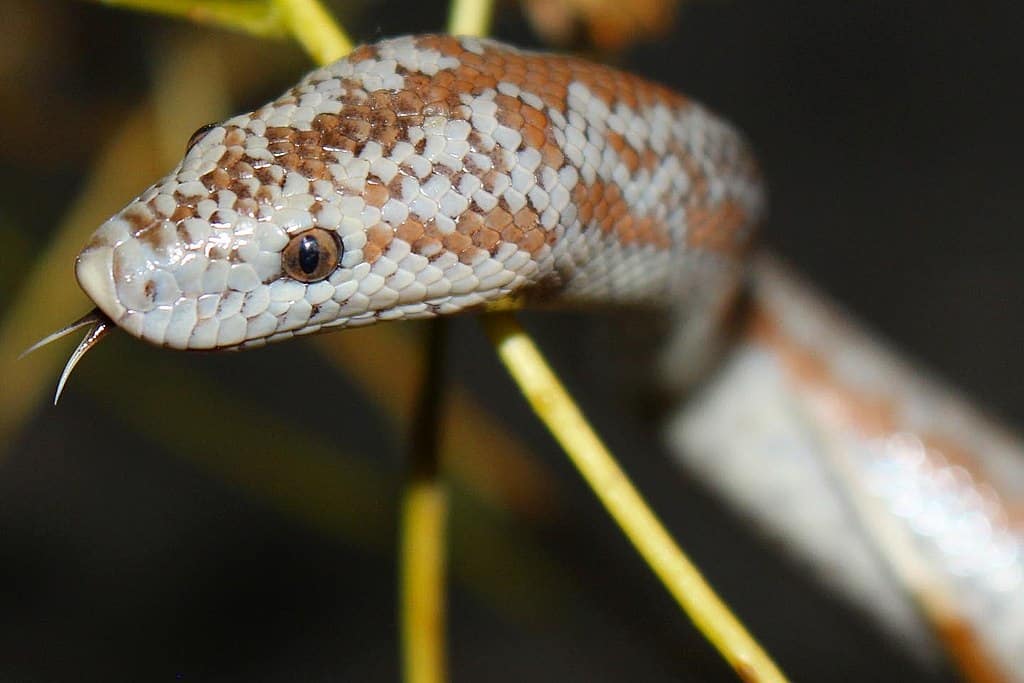
- Named for the rosy or salmon hue on their bellies, Rosy Boa constrictors hail from coastal regions in southern California and Baja California, Mexico. Contrary to the name, a majority of Rosy Boas lack this distinctive coloration on their undersides and instead feature a pattern of dark orange spots against a light-colored background. Nearly all Rosy Boas exhibit at least some indication of three longitudinal stripes: one along the center of the back and two on the lower sides. Thriving primarily in rocky, desert landscapes, these boas adeptly find refuge from potential predators.
Sand Boa

- Residing in arid grasslands in Northeastern Africa and the southern extremity of the Arabian peninsula, the Sand Boa constrictor snakes navigate through sand and loose soil in pursuit of small mammals and nesting birds. As temperatures rise, especially during the hotter seasons, they seek shelter beneath stones and within the burrows of small mammals. In their natural habitat, these snakes predominantly occupy shallow holes, revealing only their heads most of the time.
Rubber Boa
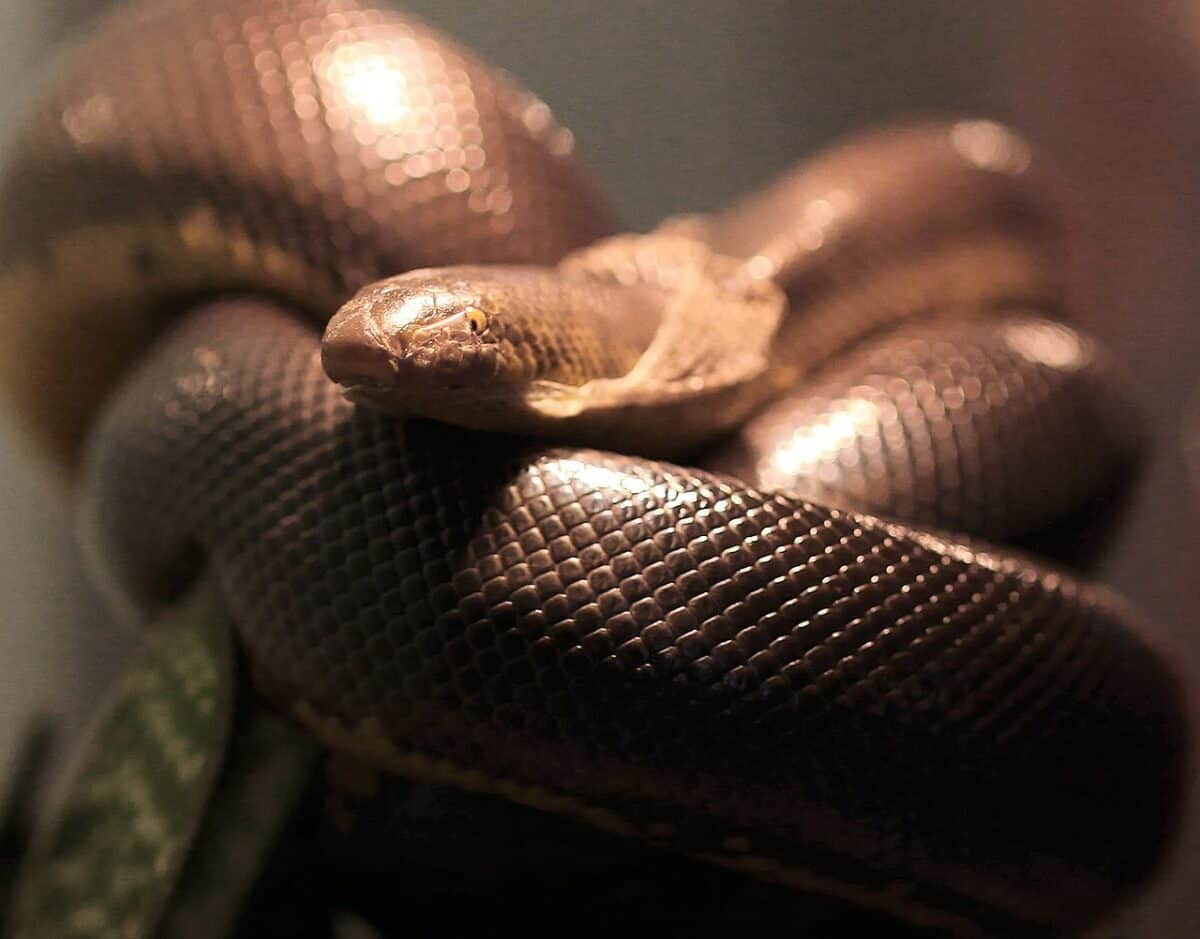
- Inhabiting the cool western regions of North America, particularly on mountainsides at elevated altitudes, Rubber Boa constrictors are one of only two boas native to the United States, alongside the Rosy Boa. These snakes primarily navigate the ground but exhibit the ability to burrow, swim, and climb trees in search of food. Remarkably compact, the Rubber Boa ranks among the smallest boas globally, with most individuals not surpassing a length of two feet.
Where to see Boa Constrictor
Although highly elusive to spot in the wild, we recommend locations that are home to these remarkable reptiles! Take a look!
The Amazon ( Central South America)
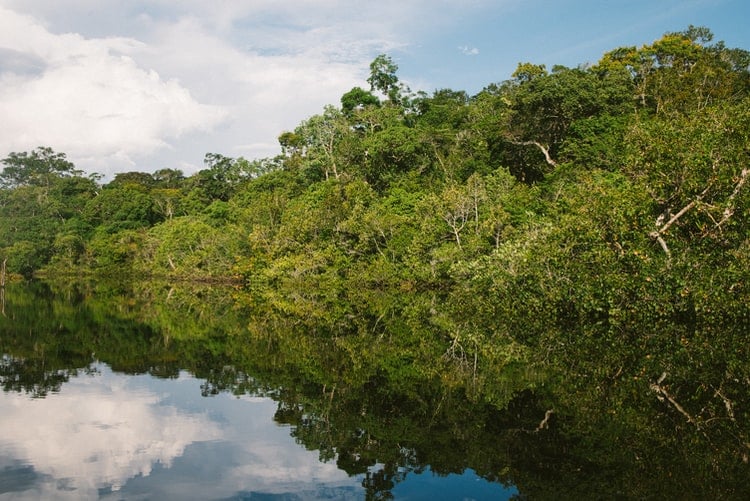
Encompassing a vast expanse of 6.7 million km2 (twice the size of India), the Amazon Biome stands unparalleled in scale, complexity, and opportunity, truly earning its reputation as a region marked by extraordinary features.
Not only does the Amazon host the largest remaining tropical rainforest globally, but it also shelters at least 10% of the world’s recognized biodiversity. This includes endemic and endangered flora and fauna. Moreover, the Amazon River, contributing 15-16% of the world’s total river discharge into the oceans, is a key component of this biome.
Stretching for over 6,600 km, the Amazon River, with its myriad tributaries and streams, boasts the highest number of freshwater fish species worldwide.
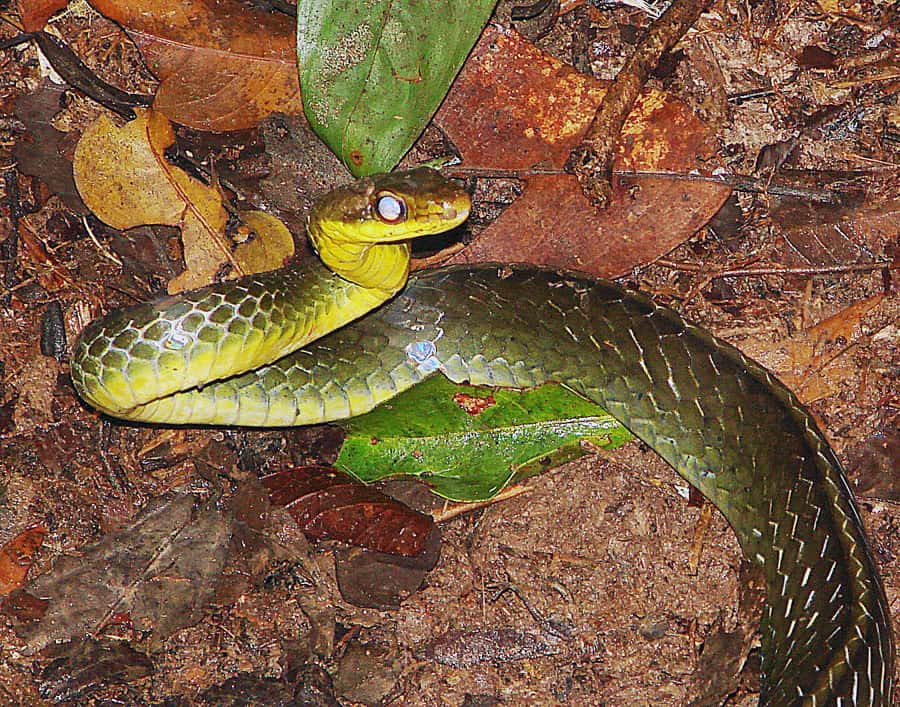
Snakes in the Amazon;
Despite the abundance of snake populations in the Amazon, encountering Boas snakes proves challenging due to their elusive and solitary behavior. However, various captivating tours traverse the vast Amazon rainforest in South America, offering fortunate individuals the opportunity to witness these snakes retreating to safety upon being spotted.
All four Anaconda species are distributed across South America, with a predominant presence in the Amazon and Orinoco river basins. Exhibiting semi-aquatic traits, Anacondas flourish in slow-moving streams, rivers, and muddy, marshy environments. Commonly referred to as “Water Boas,” these snakes demonstrate a slow and cumbersome demeanor on land, relying on their sleek bodies for swift aquatic movement. Anacondas, predominantly nocturnal, can also be observed actively during the day.
Suggested Tours & Operators
Rainforest cruises Amazon River cruises
Amazon Expeditioners Amazon walk expeditions
Mexico
Cozumel, a largely undeveloped Mexican island in the Caribbean Sea, is a popular cruise ship port of call famed for its scuba diving—a venue for natural wonders of the land and sea alike.
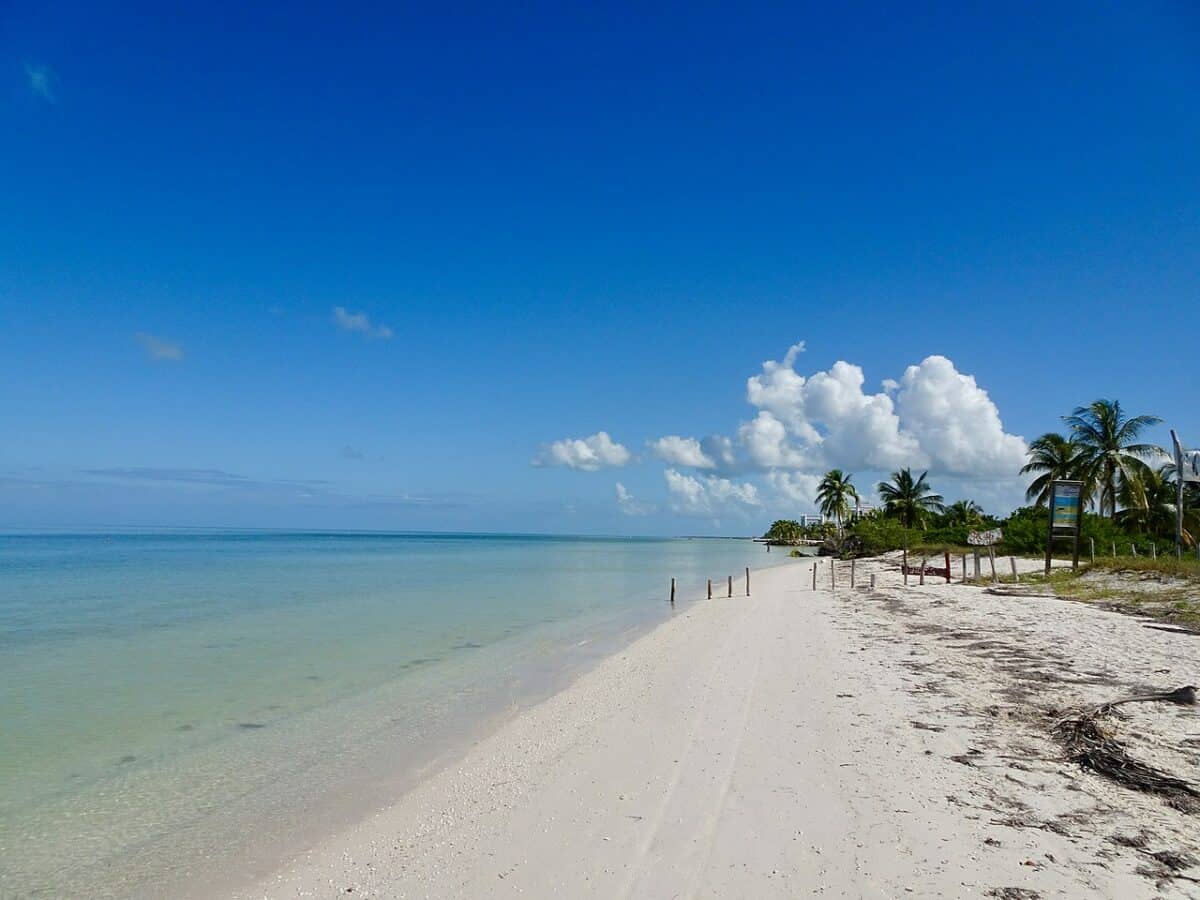
Boa constrictor snakes were introduced onto Cozumel Island, Quintana Roo, Mexico, in 1971. These snake species have now become firmly established and have a wide distribution on Cozumel. We recorded an encounter rate of 1.8 boas per 100 km of forest surveyed.
Prior to 1971, Cozumel was an island free of boa constrictors. The island did have a few other non-venomous snakes. These types of snakes are found in varying habitats across the country, but the types that reside in the jungles.
Read more about the history of the island and its reptile inhabitants here.
Suggested tours/ Operators:
Safe Tours Cozumel: Private Island tour into national parks and heritage sites
Cozumel Tours: Ecotours
Summary of the Boa Constrictor
These non-venomous snakes that are primarily found in the central tropics and Southern America, western hemisphere are highly elusive creatures of diverse environments.
Have you enjoyed this article and reading about Boa Constrictor? Learn more about the habitat of the Boa constrictor snakes in our blog featuring Chicken Snakes or all Reptiles articles. Or Watch a Komodo Dragon attack a Goat.
Join our Forum for free today!

- These are The 5 Largest Great White Sharks Ever Recorded - July 19, 2024
- The Surprising Benefits of Big Game Hunting - July 18, 2024
- $100k+ Hunting Experiences The Most Expensive Animals to Pursue - July 17, 2024

